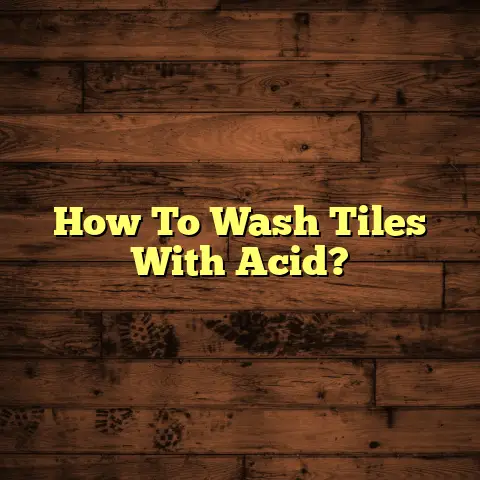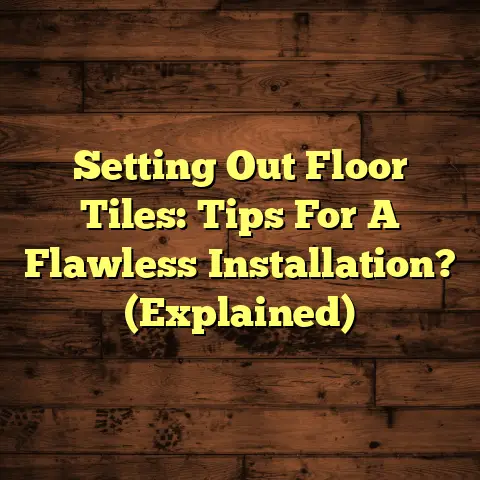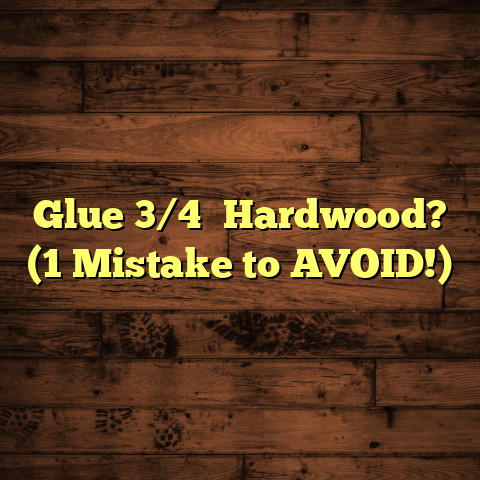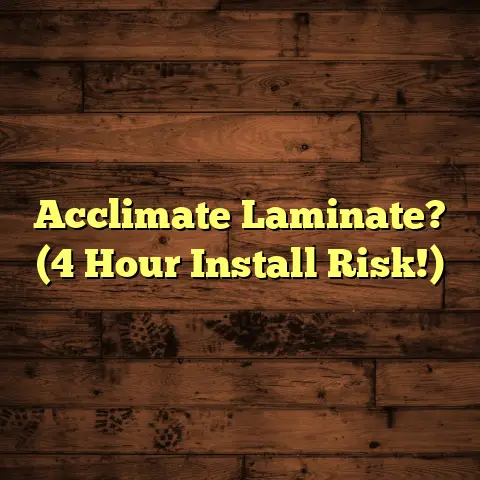Concrete Prep for Vinyl (3 Steps to Avoid!)
Ever walked into a basement and felt that damp chill seeping up from the concrete floor?
That’s the sensory stage we’re setting today.
Imagine transforming that cold, hard slab into a beautiful, comfortable vinyl floor.
Sounds great, right?
But hold on! Before you even think about unrolling that vinyl, let’s talk about concrete prep.
And more importantly, let’s discuss the mistakes I’ve seen homeowners (and even some pros!) make that lead to flooring nightmares.
I’m going to walk you through 3 critical steps you absolutely must avoid when prepping your concrete for vinyl.
Trust me, skipping these can cost you time, money, and a whole lot of frustration.
Section 1: Understanding Concrete Preparation for Vinyl Flooring
1.1 The Importance of Proper Preparation
Think of your concrete slab as the foundation of your entire flooring project.
If it’s not solid, everything you build on top of it is going to suffer.
Proper concrete preparation is absolutely essential for a successful vinyl flooring installation.
It’s like building a house – you wouldn’t skip the foundation, would you?
Here’s why it matters:
- Longevity: A properly prepped surface ensures your vinyl floor lasts for years to come.
- Adhesion: Vinyl needs a clean, even surface to properly adhere to.
- Appearance: Imperfections in the concrete will show through the vinyl, ruining the look you’re after.
- Moisture Control: Concrete can hold moisture, which can damage vinyl over time.
1.2 The Common Pitfalls
Now, here’s the thing: Not all preparation is good preparation.
I’ve seen folks spend hours “prepping” their concrete, only to end up with even bigger problems than they started with.
Why? Because they made some common, avoidable mistakes.
These pitfalls can range from neglecting crucial moisture testing to using the wrong type of patching compound.
The goal here is to help you identify these potential problems before they ruin your flooring project.
So, let’s dive into the 3 biggest concrete prep steps you should avoid.
Section 2: Step 1 to Avoid – Neglecting Moisture Testing
2.1 The Role of Moisture in Concrete
Moisture is the enemy of vinyl flooring.
I can’t stress this enough.
Concrete is porous, meaning it can absorb moisture from the ground, the air, or even from spills.
When that moisture gets trapped under your vinyl flooring, bad things happen.
Think warping, bubbling, mold growth, and adhesive failure.
According to the Portland Cement Association, concrete can take months to fully cure and release excess moisture.
Installing vinyl before the concrete is properly dried is a recipe for disaster.
2.2 Consequences of Skipping Moisture Testing
I once worked on a project where the homeowner decided to skip the moisture test.
He figured, “It’s a basement, it’s always a little damp. What’s the big deal?”
Big mistake!
Within a few months, the vinyl started to bubble and peel up.
We pulled it up and found mold growing underneath.
The entire floor had to be ripped out and replaced, costing him thousands of dollars.
I’ve seen similar situations time and time again.
It’s heartbreaking to watch someone’s dream floor turn into a moldy mess simply because they skipped a crucial moisture test.
Don’t let that be you.
2.3 Visible Signs of Moisture Problems
Before you even think about laying vinyl, take a good look at your concrete slab.
Are there any visible signs of moisture problems?
Here are a few things to look for:
- Dark Spots: These can indicate areas where moisture is seeping through the concrete.
- Efflorescence: This is a white, powdery substance that forms on the surface of concrete when moisture evaporates, leaving behind mineral salts.
- Dampness: Obviously, if the concrete feels damp to the touch, that’s a red flag.
- Mold or Mildew: Any signs of mold or mildew growth are a clear indication of moisture problems.
If you see any of these signs, you need to address the moisture issue before moving forward.
How to Test for Moisture:
There are a few different ways to test for moisture in concrete. Here are two common methods:
- Calcium Chloride Test: This involves placing a small
container of calcium chloride on the concrete surface,
sealing it, and then measuring how much moisture the
calcium chloride absorbs over a period of time.
- Source: ASTM F1869
- Relative Humidity (RH) Test: This involves drilling
small holes into the concrete and inserting probes that
measure the relative humidity within the slab.
- Source: ASTM F2170
Generally, you want to ensure moisture levels are at or below the level recommended by the vinyl flooring manufacturer.
Section 3: Step 2 to Avoid – Ignoring Surface Preparation
3.1 The Importance of a Smooth Surface
Imagine trying to lay a sheet of vinyl over a pile of rocks.
That’s essentially what you’re doing if you try to install vinyl over a rough, uneven concrete surface.
A smooth concrete surface is absolutely critical for a successful vinyl flooring installation.
Here’s why:
- Appearance: Any bumps, cracks, or imperfections in the concrete will show through the vinyl.
- Durability: A rough surface can cause the vinyl to wear unevenly and potentially tear.
- Adhesion: Vinyl needs a smooth, clean surface to properly adhere to.
- Comfort: A smooth surface provides a more comfortable walking experience.
3.2 Common Mistakes in Surface Preparation
I’ve seen so many homeowners make these mistakes.
Here are a few of the most common:
- Failing to Clean the Surface Properly: Dust, dirt, and debris can prevent the vinyl from properly adhering to the concrete.
- Neglecting to Fill in Cracks: Even small cracks can show through the vinyl and cause problems down the road.
- Not Leveling the Surface: Uneven surfaces can cause the vinyl to buckle or warp.
- Using the Wrong Type of Patching Compound: Some patching compounds are not compatible with vinyl flooring.
3.3 Preparation Techniques to Avoid
Now, let’s talk about some specific techniques you should avoid when prepping your concrete surface.
- Aggressive Grinding: Over-grinding can damage the concrete and create an uneven surface.
- Using Harsh Chemicals: Some cleaning chemicals can damage the concrete or leave behind a residue that prevents the vinyl from adhering properly.
- Inadequate Cleaning Methods: Simply sweeping the floor is not enough. You need to thoroughly clean the surface with a suitable cleaner and rinse it well.
Proper Surface Preparation Techniques:
Here’s what you should be doing:
- Cleaning: Start by thoroughly cleaning the concrete surface. Use a concrete cleaner and a scrub brush to remove any dirt, dust, grease, or other debris. Rinse well with clean water and allow the surface to dry completely.
- Patching: Inspect the concrete for any cracks, holes, or imperfections. Use a concrete patching compound to fill these in. Follow the manufacturer’s instructions carefully. Allow the patching compound to dry completely before moving on.
- Leveling: If the concrete surface is uneven, you may need to use a self-leveling compound to create a smooth, level surface. Follow the manufacturer’s instructions carefully. Allow the self-leveling compound to dry completely before moving on.
- Grinding (If Necessary): If the concrete surface is very rough, you may need to grind it down to create a smoother surface. Use a concrete grinder with a diamond grinding wheel. Be careful not to over-grind the surface.
- Final Cleaning: Once you’ve completed all of the necessary repairs and leveling, clean the concrete surface one last time to remove any dust or debris.
Section 4: Step 3 to Avoid – Overlooking the Use of Underlayment
4.1 Understanding Underlayment’s Role
Think of underlayment as a cushion between your concrete and your vinyl flooring.
It’s a thin layer of material that sits between the two surfaces, providing a number of benefits.
Here’s what underlayment does:
- Cushioning: It provides a softer, more comfortable walking surface.
- Sound Absorption: It helps to reduce noise transmission.
- Moisture Resistance: It acts as a barrier against moisture from the concrete.
- Insulation: It provides a small amount of insulation, helping to keep your floors warmer.
4.2 Consequences of Skipping Underlayment
So, what happens if you skip the underlayment?
Well, here are a few potential consequences:
- Increased Noise: Without underlayment, you’ll hear every footstep and every dropped object.
- Reduced Comfort: Your floors will feel harder and less comfortable to walk on.
- Moisture Damage: Moisture from the concrete can damage the vinyl over time.
- Voided Warranty: Some vinyl flooring manufacturers require the use of underlayment in order to maintain the warranty.
4.3 Choosing the Right Underlayment
Not all underlayment is created equal.
There are a variety of different types of underlayment available, each with its own pros and cons.
Here are a few common mistakes people make when choosing underlayment:
- Choosing the Wrong Thickness: Using an underlayment that is too thick or too thin can cause problems.
- Ignoring Moisture Resistance: If you’re installing vinyl in a damp area, you need to choose an underlayment that is specifically designed to resist moisture.
- Not Considering Sound Absorption: If you’re concerned about noise, you need to choose an underlayment that has good sound absorption properties.
- Buying Cheap Underlayment: Cheap underlayment is often made from low-quality materials and may not provide the necessary cushioning or moisture resistance.
Types of Underlayment:
Here are a few common types of underlayment:
- Foam Underlayment: This is a popular choice for vinyl flooring because it provides good cushioning and sound absorption.
- Cork Underlayment: Cork is a natural material that is moisture resistant and provides good insulation.
- Rubber Underlayment: Rubber is a durable material that is resistant to moisture and provides good cushioning.
Choosing the Right Underlayment:
The best way to choose the right underlayment is to consult with a flooring professional.
They can help you assess your specific needs and recommend the best underlayment for your project.
Conclusion: The Path to Successful Vinyl Flooring Installation
Remember that damp, chilly basement we started with?
Imagine it now, transformed into a warm, inviting space with beautiful vinyl flooring.
You can make that dream a reality, but only if you avoid the three concrete prep pitfalls we’ve discussed.
Skipping moisture testing, ignoring surface preparation, and overlooking the use of underlayment can all lead to flooring disasters.
But if you take the time to properly prepare your concrete surface, you’ll be rewarded with a beautiful, durable, and long-lasting vinyl floor.
The foundation you lay today will resonate in every step taken on the finished floor, creating a lasting impression for years to come.
So, take your time, do your research, and don’t be afraid to ask for help.
Your dream floor is waiting!





